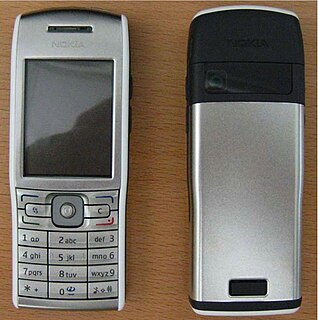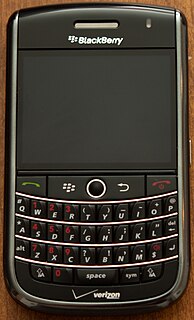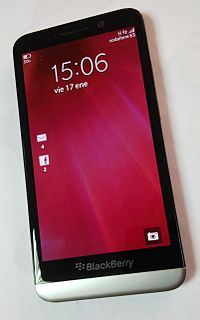Related Research Articles
Bluetooth is a short-range wireless technology standard that is used for exchanging data between fixed and mobile devices over short distances using UHF radio waves in the ISM bands, from 2.402 GHz to 2.48 GHz, and building personal area networks (PANs). It was originally conceived as a wireless alternative to RS-232 data cables. It is mainly used as an alternative to wire connections, to exchange files between nearby portable devices and connect cell phones and music players with wireless headphones. In the most widely used mode, transmission power is limited to 2.5 milliwatts, giving it a very short range of up to 10 meters (30 feet).

A personal digital assistant (PDA), also known as a handheld PC, is a variety mobile device which functions as a personal information manager. PDAs have been mostly displaced by the widespread adoption of highly capable smartphones, in particular those based on iOS and Android.

BlackBerry is a brand of smartphones, tablets, and services originally designed and marketed by Canadian company BlackBerry Limited. Beginning in 2016, BlackBerry Limited licensed third-party companies to design, manufacture, and market smartphones under the BlackBerry brand. The original licensors were BB Merah Putih for the Indonesian market, Optiemus Infracom for the South Asian market, and BlackBerry Mobile for all other markets. In summer 2020, the Texas-based startup OnwardMobility signed a new licensing agreement with BlackBerry Limited to develop a new 5G BlackBerry Smartphone. The device, which will probably be released in 2021, is expected to have flagship specifications and a BlackBerry-typical physical keyboard. For the creation of the new BlackBerry-branded smartphones, OnwardMobility is cooperating with BlackBerry Limited and FIH Mobile.

An intelligent transportation system (ITS) is an advanced application which aims to provide innovative services relating to different modes of transport and traffic management and enable users to be better informed and make safer, more coordinated, and 'smarter' use of transport networks.

A mobile device is a computer small enough to hold and operate in the hand. Typically, any handheld computer device will have an LCD or OLED flatscreen interface, providing a touchscreen interface with digital buttons and keyboard or physical buttons along with a physical keyboard. Many such devices can connect to the Internet and interconnect with other devices such as car entertainment systems or headsets via Wi-Fi, Bluetooth, cellular networks or near field communication (NFC). Integrated cameras, the ability to place and receive voice and video telephone calls, video games, and Global Positioning System (GPS) capabilities are common. Power is typically provided by a lithium-ion battery. Mobile devices may run mobile operating systems that allow third-party applications to be installed and run.

The Palm Treo 650 is a Palm OS-based smartphone, the successor to Palm's Treo 600. It began shipping in November 2004, and was discontinued in 2008.
Push email is an email system that provides an always-on capability, in which new email is actively transferred (pushed) as it arrives by the mail delivery agent (MDA) to the mail user agent (MUA), also called the email client. Email clients include smartphones and, less strictly, IMAP personal computer mail applications.

The Nokia E50 Business Device is a bar-style monoblock quad-band smartphone from Nokia announced 18 May 2006 as part of the Eseries, intended primarily for the corporate business market. It includes sophisticated e-mail support for Nokia's Intellisync Wireless Email, BlackBerry Connect, Visto Mobile, Activesync Mail for Exchange, Altexia as well as IMAP4. It also has the ability to view Microsoft Word, PowerPoint, and Excel attachments, and PDF documents but it cannot be used for editing these without additional apps. An application manager downloads, removes and installs both Nokia and third-party applications. Device to device synchronization is possible with Data transfer application. Features include EDGE, Bluetooth 2.0, a 1,280 × 960 pixels (1.3-megapixel) camera, a MicroSD memory-card slot, and digital music and video player functionality through RealPlayer and Flash Player. This unit does not support UMTS, Wi-Fi, or FM radio.
Various accessories for the PlayStation 3 video game console have been produced by Sony and third-party companies. These include controllers, audio and video input devices like microphones, video cameras, and cables for better sound and picture quality.

The BlackBerry Pearl was a series of smartphones developed by Research In Motion, and was the first BlackBerry device with a camera and media player. It was originally released on September 12, 2006. T-Mobile was the first US carrier to release the phone as a carrier device. The last BlackBerry Pearl released was the 9100 series on May 13, 2010. After this model was cleared out, RIM discontinued the Pearl series.
Fixed–mobile convergence (FMC) is a change in telecommunications that removes differences between fixed and mobile networks.
Airplane mode, aeroplane mode, flight mode, offline mode, or standalone mode is a setting available on smartphones and other portable devices. When activated, this mode suspends the device's radio-frequency (RF) signal transmission technologies, effectively disabling all analog voice, and digital data services, when implemented correctly by the electronic device software author. When cellular phones became prevalent in the 1990s, some communication headsets of aircraft pilots would register an audible click when a cellular phone on the aircraft would transceive a signal. This clicking on the headsets became overwhelmingly distracting to airframe control, with more and more phone calls from airplane passengers as time went on. This led to the banning of electronic device use on airplanes and ushered in the era of airplane mode. This airplane travel condition diverged cellular network device development from hardware to software and the smart phone was created.

The BlackBerry Storm is a touchscreen smartphone developed by Research In Motion. A part of the BlackBerry 9500 series of phones, it was RIM's first touchscreen device, and its first without a physical keyboard. It featured a touchscreen that responded like a button via SurePress, Research In Motion haptic feedback technology. Its competitors included Apple's iPhone, the Palm Pre, the T-Mobile G1 by HTC and the HTC Touch family.

The BlackBerry Tour is a mobile device developed by Research In Motion and is part of the 9600 device series. This high-end messaging phone combines the multimedia features of the Curve with the global roaming of the 8830, plus a higher-resolution display, 3.2-megapixel auto-focus camera, 3G data overseas and faster EVDO Rev. A data in the United States and Canada. Other key features include voice calling, video capture, 3.5mm audio jack, memory card slot, push email, QWERTY keyboard, Bluetooth, and GPS navigation. The BlackBerry Tour was released on July 12, 2009. In 2010, the "Tour 2" refresh was re branded the Blackberry Bold 9650 when RIM decided to merge the GSM and CDMA2000 variants under the same brand.
A connected car is a car that can communicate bidirectionally with other systems outside of the car (LAN). This allows the car to share internet access, and hence data, with other devices both inside and outside the vehicle. For safety-critical applications, it is anticipated that cars will also be connected using dedicated short-range communications (DSRC) or cellular radios, operating in the FCC-granted 5.9 GHz band with very low latency.
MyLink a.k.a. Intellilink is a telematics system/infotainment system offered by General Motors in their vehicles. The system was debuted in 2011 in the then-new Chevrolet Volt.

CarPlay is an Apple standard that enables a car radio or head unit to be a display and a controller for an iOS device. It is available on all iPhone models beginning with iPhone 5 running iOS 7.1 or later.

The BlackBerry Z30 is a high-end 4G touchscreen smartphone developed by BlackBerry. Announced on September 18, 2013, it succeeds the Z10 as the second totally touchscreen device to run the BlackBerry 10 operating system. The Z30 includes a 5-inch 720p Super AMOLED display with "quad-core graphics", speakers and microphones with "Natural Sound" technology, six processor cores and a non-removable 2880 mAh battery. The BlackBerry Z30 also uses Paratek Antenna Technology. This refers to the number of proprietary advancements in antenna hardware and tuning technology that is aimed to improve performance especially in regions with low signal.
Automotive hacking is the exploitation of vulnerabilities within the software, hardware, and communication systems of automobiles.
References
- ↑ Reuters
- ↑ "Archived copy". Archived from the original on 2010-01-16. Retrieved 2010-02-11.CS1 maint: archived copy as title (link)
- ↑ Pogue, David (18 March 2009). "A Voice in Your Ear, Sorting Mail". The New York Times.
- ↑ "Archived copy". Archived from the original on 2010-05-23. Retrieved 2010-01-21.CS1 maint: archived copy as title (link)
- ↑ "Archived copy". Archived from the original on 2012-07-18. Retrieved 2011-03-29.CS1 maint: archived copy as title (link)